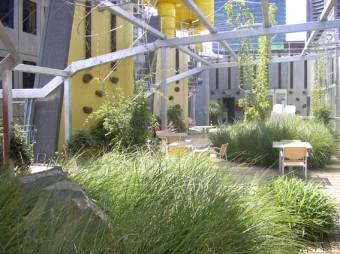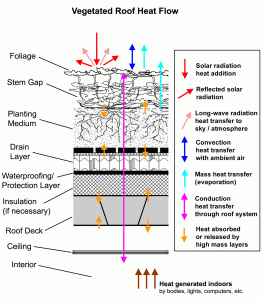Week 3 Lecture 11.8.16 by John Blair
Background
Popular in parts of Eurpoe for decades; but limited interest in Australia. Maybe because there’s less pressure? We already have such plentiful green spaces available.
What are green roofs?
Roofs covered with plant material. Can be an extensive roof – involving a growing medium, filter membrane, drainage layer, root barrier, insulation then waterproof roof membrane (50 – 200mm total depth on average); or an intensive roof – essentially the same setup but the substrate varies in depth from 200mm to 1500mm so it’s much deeper, and therefore much heavier. This process may involve strengthening the bearing capacity of the roof meaning that the decision to create a green roof needs to be decided early on in the design process.
The depth of the substrate also determines the range of plants it can support – generally speaking, the deeper the substrate, the larger the plants it can support – some can even support trees!

Green Roof with tables/chairs at CH2, Melbourne
Green Roofs and Heat Flow
- Conduction – moving heat from a hot molecule to a cool one
- Convection – Moving heat using a flowing gas or liquid
- Radiation – Heat rtansfer from warmer surfaces to cooler surfaces
- Evaportaion – Mass heat trasnsfer
- Thermal Mass – Ability to store heat in something
Evapo-transpiration – transfer of water from soil to pores of leaf. Removes 30% of excess heat. The bigger the plant, the greater the cooling. This reduces the building cooling load – saving energy and cost.

A green roof will absorb heat from outside and then slowly release the heat back outside when it cools down.
Green Roof Benefits
- Carbon Sequestration – absorbing carbon storage
- Energy saving through the cooling effect/ radiation protection
- Stormwater Detention – Vegetation retains storwater to carry out normal functions. This can also save on stormwater infrastructure
- Reduces LOCAL temperature in the city through evaporative cooling and slightly lowers the UHI (Urban Heat Island) BUT this requires green roofs on a large scale.
- UHI Reduction
- Better air quality – pollutants trapped or ingested by plant life
- Biodiversity Enhancement
- Improved efficiency of PV cells
Green Roof Disdvantages
- privacy/noise
- bearing capacity
- suitability
- negative results where fertiliser is required
Green Roof Alternatives
- Cool Roofs
Conclusions
- Benefits are not individually large
- Cumulatively, however, all of the benfits could be incredibly significant
- Only building feature to offer multiple benefits simultaneously
Further Resources
http://www.greencities.org.au/

That’s a neat diagram of a green roof. I’ve not seen one with the heat balance in it. What’s the source of it? I’d like to use it at work to educate those who still think a green roof is less secure than a ballast roof, and that lawnmowers are needed (eye roll)
LikeLike
Check this out: https://www.cmu.edu/environment/campus-green-design/green-roofs/documents/heat-transfer-and-thermal-performance-analysis.pdf
Page 36 has the diagram on it. Hope this helps!
Plus there’s also heaps of cool info here if you need it: http://www.greenroofs.com/
LikeLike
Thanks!
LikeLike